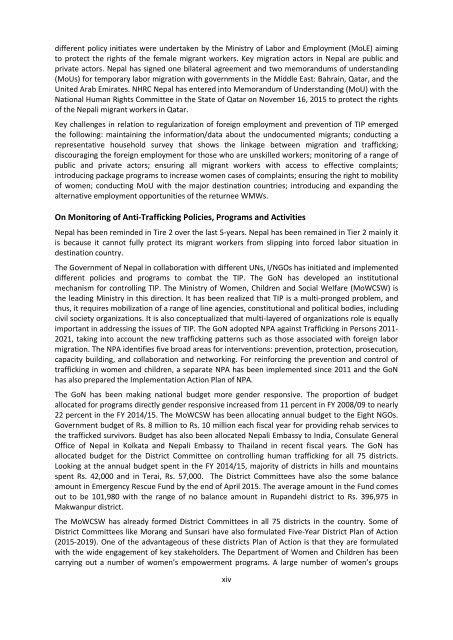TRAFFICKING IN PERSONS
1Spfyta
1Spfyta
You also want an ePaper? Increase the reach of your titles
YUMPU automatically turns print PDFs into web optimized ePapers that Google loves.
On Legal Framework, Enforcement and Judicial Responses<br />
Nepal is a state party of major human rights instruments. However, Nepal has yet to be the state<br />
party of UN Protocol on Trafficking 2000; UN Convention on Right of the Migrant Workers and Their<br />
Families, 1990 and ILO Convention 189 on Domestic Workers 2011. Nepal has adopted Human<br />
Trafficking and Transportation (Control) Act 2007 and Regulation 2008. Nepal Police is the law<br />
enforcement agency. It has created Women and Children Service Directorate (WCSD) and Central<br />
Investigation Bureau (CIB) to effectively deal with the trafficking crime. The CIB during the FYs<br />
2013/14 and 2014/15 carried out different raids, arrests through its special programs to combat TIP<br />
especially. Despite these efforts, there is relatively large number of trafficking accused persons<br />
absconded vis-à-vis the arrested persons.<br />
The implementation status of the HTTCA 2007 and Regulations 2008 is basically assessed by drawing<br />
upon the findings of the recent studies (FWLD, 2014; NJA, 2013 and Kunwar, 2014) and regional and<br />
national level workshops organized by NHRC in the year of 2014 and 2015 among the key<br />
stakeholders. It is difficult to assess the implementation status objectively due to the lack of<br />
consolidated data and the assessment is more subjective. The level of compliance is assigned as low,<br />
low-to-moderate and moderate. Low compliance refers to the conditions in which provisions<br />
embodied in the Act/Regulation have not been implemented at all or implementation is highly<br />
unsatisfactory. Low-to-moderate level of compliance is defined as the movement towards<br />
satisfactory conditions. Moderate compliance refers to the conditions in which provisions have not<br />
been fully realized but they are at the state of satisfactory level. The analysis reveal that the level of<br />
compliance in relation to definition of offences and investigation is low-to-moderate; ii) provisions<br />
relating to rescue, rehabilitation, and reintegration is low; iii) provisions relating to punishment and<br />
compensation is low-to-moderate and iv) provisions relating to others (award, confidentiality,<br />
formation of committee and security and in-camera hearing) is low-to-moderate.<br />
In FY 2013/14, a total of 1,007 trafficking cases were registered in the Supreme Court, Appellate<br />
Courts and District Courts of Nepal. This accounts for less than one percent of the total cases<br />
(158,699). The Supreme Court of Nepal has time and again ordered the GoN to amend the HTTA<br />
2007, particularly in the following areas: amending the Section 15(6), making compulsory<br />
arrangement to provide the information to the victims, establishing the Compensation Fund, making<br />
compulsory budget for the witness appearing in the court; paying the Daily Service Allowances<br />
incurred for attending the court to the witnesses of the Government cases; and arranging the<br />
security to the victims and informants. The Supreme Court has also issued an order in the name of<br />
MoHA, OAG and Register of the Supreme Court for continuous hearing of the serious nature of the<br />
crimes such as trafficking and rape. Recently, the Legislature-Parliament has amended some Section<br />
of the HTTCA 2007.<br />
The conviction rates of TIP in the courts declines as one move from the district courts to appellate<br />
courts to the Supreme Court. The five-year (2008/09-2013/14) average conviction rate in the<br />
Supreme Court is 33 while it 44 percent in appellate courts and 58 percent in districts courts of<br />
Nepal.<br />
Key challenges in relation to law enforcement and judicial response are to increase the effective<br />
implementation of the Act; increase efforts to enforce the laws; develop the functional capacity and<br />
professional efficiency of prosecutors and judges; increase efforts to maintain the privacy of the<br />
xvi


